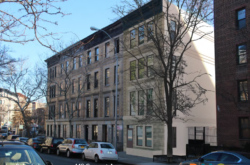
449 Convent Avenue rendering. Image credit: LPC.
19th-century rowhouse that previously stood at site demolished by emergency declaration after owner failed to make repairs following fire. On July 24, 2018, Landmarks voted to approve the construction of a new building at 449 Convent Avenue in the Hamilton Height/Sugar Hill Historic District Extension. An 1897 Renaissance Revival rowhouse occupied the site until 2011, when it was demolished by the Department of Buildings under an emergency declaration. The demolition followed a severe fire, and the building was declared unsafe after the owner failed to make necessary repairs.
Landmarks held a public hearing regarding the property on January 23, 2018. At the time the applicants proposed a four-story building, with a setback fifth-floor penthouse, with an additional rooftop bulkhead. Architect Parag Mehta, of PM Architecture, presented a design of a scale and with window patterns intended to recall the lost building in a more contemporary idiom. Facade brick would closely match the brick on the adjoining building, and the window pattern would be similarly to bookending rowhouse at the opposite end of the block. The penthouse would be set back 15 feet from the front facade, and a stair bulkhead would rise above the penthouse.
A side yard would separate the new building from the existing building to the east, making the penthouse and bulkhead visible to passersby. The rooftop massing would be minimally visible from other perspectives. The new building extend to the rear property line, the only building in the row to do so. The sidewall would be clad with an exterior insulation and finish system for reasons of insulation and energy efficiency.
Patrick Waldo, representing the Historic Districts Council, conceptually approved of the building’s deference to its neighbors as a modest infill building, but took issue with many of the details. Waldo stated the facade should be refined so windows were not set within the cornice, but below it, and the visible sidewall faced in EIFS was entirely inappropriate for a historic district.
Chair Meenakshi Srinivasan stated that Community Board 9 opposed the project, resolving that the fifth floor was out of context with the district, and architects should work to design the visible side facade, possibly incorporating windows.
Srinivasan said the building was generally appropriate in massing and design, but the penthouse story should be removed or substantially reduced in visibility. Commissioner Michael Devonshire commented that the EIFS was a “poor, low-level” material that was unacceptable given the sidewall’s visibility. He advised the applicants to study visible secondary walls on historic buildings in the district. He also said the project’s details required significant refinement to ensured it didn’t appear as “watered-down” imitation of the block’s historic rowhouses. Commissioner Fred Bland opined that brick or stucco would be a more appropriate material for the sidewall. He did not find the penthouse inappropriate. He said the design drew from appropriate resources, but its details needed to be worked out “more carefully,” particularly on the ground floor.
Srinivasan asked the applicants to minimize or remove the penthouse, and to develop their design more fully and present the plan to the Commission again.
In the revised proposal, presented by Mehta, the applicants removed the setback story and stair bulkhead from the plan. Rooftop furniture would be limited to a boiler room bulkhead, set away from both the front and east side facades. A glass railing above the cornice would enclose the roof. The revised plan also included an areaway enclosure. The cornice and window surrounds were modified to better relate to the adjoining row, and brick bandcourses on the facade would align with those of the historic rowhouses. A stucco sidewall was proposed in the revised plan, while the front and rear would be faced in brick.
A column of windows at the corner of the side wall would smooth the transition between the two facades.
Commissioners found the revised proposal responsive to issues raised at the hearing, though recommended that a cable railing, rather than a glass railing, be used at the roof.
The applicants acceded to the railing suggestion, and Acting Chair Fred Bland led a unanimous vote to issue a modified Certificate of Appropriateness for the project.
LPC: 449 Convent Avenue, Manhattan (LPC-19-15103) (July 24, 2018) (Architects: PM Architecture).
By: Jesse Denno (Jesse is a full time staff writer for the Center for NYC Law.)

